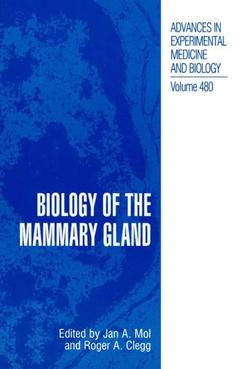Description
Biology of the Mammary Gland, 2002
Advances in Experimental Medicine and Biology Series, Vol. 480
Coordinators: Mol John A., Clegg Roger A.
Language: English
Subjects for Biology of the Mammary Gland:
Keywords
Mamma; Tumor; biology; biosynthesis; cell lines; genes; infections; signal transduction
Biology of the Mammary Gland
Publication date: 04-2013
314 p. · 15.5x23.5 cm · Paperback
Publication date: 04-2013
314 p. · 15.5x23.5 cm · Paperback
Approximative price 229.99 €
Subject to availability at the publisher.
Add to cart
Biology of the mammary gland (POD)
Publication date: 08-2000
Support: Print on demand
Publication date: 08-2000
Support: Print on demand
Description
/li>Contents
/li>
Proceedings of the European Cooperation in the Field of Scientific and Technical Research (COST 825) Symposium on Mammary Gland Biology, held September 16-18, 1999, in Tours, France.
It is difficult to overstate the evolutionary and functional significance of mammary tissue in biology. Substantial progress has been made by researchers in various disciplines, particularly over the last fifteen years, towards realizing the potential of this tissue to yield powerful experimental models for morphogenesis and tissue development; for cellular differentiation; for the biosynthesis and secretion of proteins, lipids, small molecules and inorganic salts; and for the coordination and regulation of these processes. More recently, the possibility of exploiting the secretory epithelial cells of mammary tissue as `cell factories' has become a reality and the recombinant production by lactating animals of an increasing number of proteins, valuable both in the pharmaceutical and `nutraceutical' fields, is in progress or under development.
Also in this sphere of agricultural production, genetic as well as nutritional technologies are under investigation and exploitation to optimize milk composition for various end-uses - for instance in food process and manufacture. The possibilities of deriving health benefit from the bioactive properties of some of the minor constituents of milk are emerging to counter the highly-publicized negative health impact of excessive consumption of saturated animal fats. In human nutrition and medicine, the mammary gland is both a source of nutrition to the neonate and a potential health threat to the adult female - breast cancer remains the major single cause of female mortality in most developed countries.
This volume provides a unique glimpse into our understanding, at the cutting edge of a variety of disciplines, of this versatile and extraordinary tissue, at the birth of the twenty-first century.
It is difficult to overstate the evolutionary and functional significance of mammary tissue in biology. Substantial progress has been made by researchers in various disciplines, particularly over the last fifteen years, towards realizing the potential of this tissue to yield powerful experimental models for morphogenesis and tissue development; for cellular differentiation; for the biosynthesis and secretion of proteins, lipids, small molecules and inorganic salts; and for the coordination and regulation of these processes. More recently, the possibility of exploiting the secretory epithelial cells of mammary tissue as `cell factories' has become a reality and the recombinant production by lactating animals of an increasing number of proteins, valuable both in the pharmaceutical and `nutraceutical' fields, is in progress or under development.
Also in this sphere of agricultural production, genetic as well as nutritional technologies are under investigation and exploitation to optimize milk composition for various end-uses - for instance in food process and manufacture. The possibilities of deriving health benefit from the bioactive properties of some of the minor constituents of milk are emerging to counter the highly-publicized negative health impact of excessive consumption of saturated animal fats. In human nutrition and medicine, the mammary gland is both a source of nutrition to the neonate and a potential health threat to the adult female - breast cancer remains the major single cause of female mortality in most developed countries.
This volume provides a unique glimpse into our understanding, at the cutting edge of a variety of disciplines, of this versatile and extraordinary tissue, at the birth of the twenty-first century.
Fibroblast Growth Factor Signalling and Cyclin D1 Function are Necessary for Normal Mammary Gland Development during Pregnancy.- Hepatocyte Growth Factor and Neuregulin in Mammary Gland Cell Morphogenesis.- Expression and Localization of Growth Factors during Mammary Gland Development.- Involvement of Growth Factors in the Regulation of Pubertal Mammary Growth in Cattle.- Insulin-like Growth Factor Binding Protein-5 (IGFBP-5) Potentially Regulates Programmed Cell Death and Plasminogen Activation in the Mammary Gland.- Somatostatin and Opioid Receptors in Mammary Tissue.- Heparan Sulphate.- Progestin-induced Mammary Growth Hormone (GH) Production.- Translocation and Action of Polypeptide Hormones within the Nucleus.- Mammary Gland Development and the Prolactin Receptor.- Paracrine Mechanisms of Mouse Mammary Ductal Growth.- Targeting of PKA in Mammary Epithelial Cells.- The PEA3 Group of ETS-related Transcription Factors.- Transcription Factor NF 1 Expression in Involuting Mammary Gland.- The Elf Group of Ets-Related Transcription Factors.- The Role of Stat3 in Apoptosis and Mammary Gland Involution.- Synergistic and Antagonistic Interactions of Transcription Factors in the Regulation of Milk Protein Gene Expression.- Nucleosome Organisation of the ?-Lactoglobulin Gene.- Chromatin Remodeling in Hormone-Dependent and - Independent Breast Cancer Cell Lines.- The Use of Transplanted Mammary Gland to Study Cancer Signalling Pathways.- Development of Mammary Gland Requires Normal ?l-Integrin Function.- Repression of the Putative Tumor Suppressor Gene Bardl or Expression of Notch4(Int-3) Oncogene Subvert the Morphogenetic Properties of Mammary Epithelial Cells.- Oncogene Mediated Signal Transduction in Transgenic Mouse Models of Human Breast Cancer.- Caspases: Decoders ofApoptotic Signals During Mammary Involution.- The Role of Plasminogen Activator in the Bovine Mammary Gland.- Regulation and Nutritional Manipulation of Milk Fat.- Effect of Feeding Pattern and Behaviour on Hormonal Changes and Milk Composition.- Genetic Polymorphisms in Milk Protein Genes and their Impact on Milk Composition.- Mammary Gland Immunology Around Parturition.- Cells and Cytokines in Inflammatory Secretions of Bovine Mammary Gland.- Immune Surveillance of Mammary Tissue by Phagocytic Cells.- Mammary Gland Immunology And Neonate Protection In Pigs.- Relationship Between Teat Tissue Immune Defences and Intramammary Infections.- Immunological Aspectsof Pregnancy-Associated Glycoproteins.- Vaccines Against Bovine Mastitis due to Streptococcus uberis Current Status and Future Prospects..
© 2024 LAVOISIER S.A.S.




